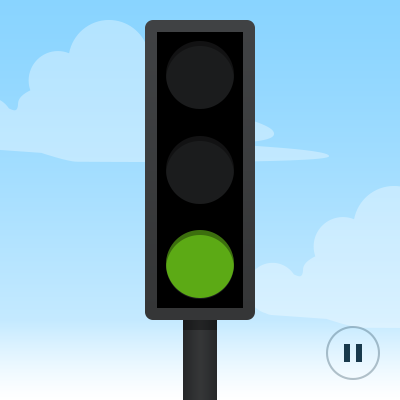
A Qt Quick application that uses a dynamically loaded state machine to implement a traffic light.

Traffic Light QML demonstrates how to connect to the active properties of a state in a dynamically loaded state machine.
The UI is created using Qt Quick.
To run the example from Qt Creator, open the Welcome mode and select the example from Examples. For more information, see Qt Creator: Tutorial: Build and run.
We link against the Qt SCXML module by adding the following lines to the example's build files.
To .pro when using qmake:
QT += qml scxml
To CMakeLists.txt when using cmake:
find_package(Qt6 REQUIRED COMPONENTS Core Gui Qml Scxml)
target_link_libraries(trafficlight-qml-dynamic PRIVATE
Qt6::Core
Qt6::Gui
Qt6::Qml
Qt6::Scxml
)
We dynamically create the state machine in the main QML file:
import QtScxml import TrafficLightApplication Window { width: lights.width height: lights.height visible: true Lights { id: lights stateMachine: loader.stateMachine // Suppress qmllint warning, dynamic statemachine properties not known at compile-time // qmllint disable missing-property button.source: stateMachine.working ? "pause.png" : "play.png" button.onClicked: stateMachine.submitEvent(stateMachine.working ? "smash" : "repair"); // qmllint enable missing-property } StateMachineLoader { id: loader source: Qt.resolvedUrl("statemachine.scxml") } }
In the SCXML file, we specify states for each light: red, yellow, and green. In the <onentry> element, we specify the event to send when entering the state and the delay in seconds before
sending the event. In the <transition> element, we specify the event that triggers the transition to the state specified by the target attribute:
<state id="red">
<onentry>
<send event="startGoingGreen" delay="3s"/>
</onentry>
<transition event="startGoingGreen" target="redGoingGreen"/>
</state>
<state id="yellow" initial="greenGoingRed">
<state id="redGoingGreen">
<onentry>
<send event="goGreen" delay="1s"/>
</onentry>
<transition event="goGreen" target="green"/>
</state>
<state id="greenGoingRed">
<onentry>
<send event="goRed" delay="1s"/>
</onentry>
<transition event="goRed" target="red"/>
</state>
</state>
<state id="green">
<onentry>
<send event="startGoingRed" delay="3s"/>
</onentry>
<transition event="startGoingRed" target="greenGoingRed"/>
</state>
We connect to the states as follows:
states: [ // Suppress qmllint warning, dynamic statemachine properties not known at compile-time // qmllint disable missing-property State { name: "Red" when: lights.stateMachine.red PropertyChanges { redLight.opacity: 1 } }, State { name: "RedGoingGreen" when: lights.stateMachine.redGoingGreen PropertyChanges { redLight.opacity: 1 } PropertyChanges { yellowLight.opacity: 1 } }, State { name: "Yellow" when: lights.stateMachine.yellow || lights.stateMachine.blinking PropertyChanges { yellowLight.opacity: 1 } }, State { name: "Green" when: lights.stateMachine.green PropertyChanges { greenLight.opacity: 1 } } // qmllint enable missing-property ]

As part of the free Business evaluation, we offer a free welcome call for companies, to talk about your requirements, and how the Felgo SDK & Services can help you. Just sign up and schedule your call.
Sign up now to start your free Business evaluation:

